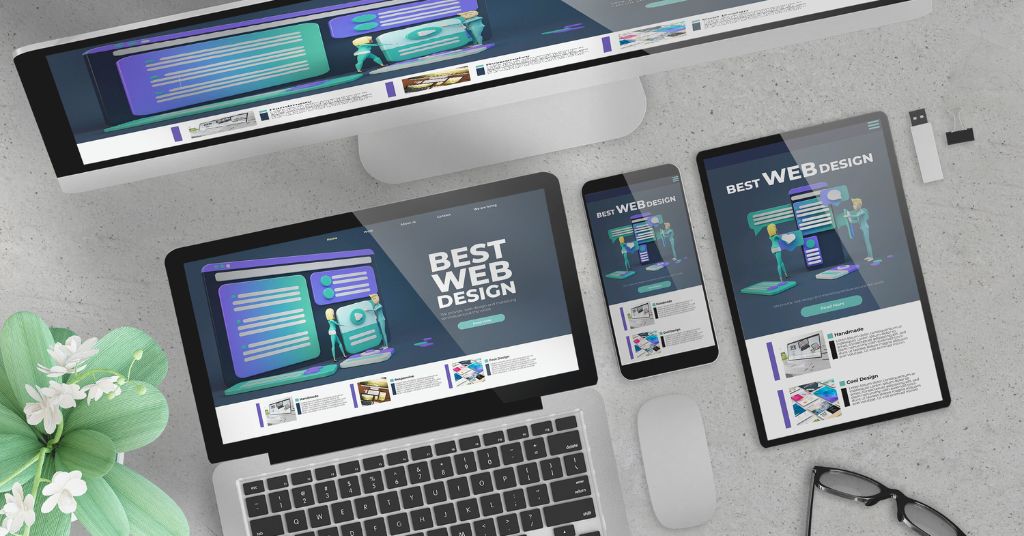When you’re designing a website in Webflow, it’s easy to overlook some critical aspects that can significantly impact user experience. You might find yourself ignoring responsive design, which can alienate a large portion of your audience, or creating navigation that’s overly complicated. These common mistakes can lead to high bounce rates and frustrated visitors. So, what can you do to ensure your site not only attracts but retains users? Let’s explore some key strategies to avoid these pitfalls and optimize your design for successful webflow website design.
Ignoring Responsive Design
Ignoring responsive design can lead to a frustrating user experience that ultimately drives visitors away. When you create a website without considering how it’ll look on different devices, you risk alienating a significant portion of your audience.
Think about it: if someone visits your site on their smartphone and finds it hard to navigate or read, they’ll likely leave and look for a competitor who offers a better experience.
Responsive design ensures that your website adapts seamlessly to various screen sizes, from desktops to tablets and smartphones. By using fluid grids and flexible images, you can maintain a consistent appearance and functionality across all devices.
This not only enhances user experience but also boosts your site’s SEO ranking. Search engines prioritize mobile-friendly sites, so failing to implement responsive design could hurt your visibility online.
To avoid this mistake, test your website on multiple devices regularly. Tools like browser developer tools and responsive design checkers can help you spot issues early.
Overcomplicating Navigation
When it comes to web design, it’s easy to fall into the trap of overcomplicating navigation. You might think that adding multiple dropdowns, intricate menus, or a plethora of links will enhance user experience. In reality, it can create confusion and frustration for visitors trying to find what they need.
Simplifying your navigation is key. Prioritize clarity and ease of use. Use straightforward labels that clearly communicate where each link leads. Aim for a maximum of seven main navigation items; this helps users quickly scan and understand their options without feeling overwhelmed.
Consider implementing breadcrumb navigation for deeper site structures. This allows visitors to track their location within your site and easily backtrack if needed.
Don’t forget about mobile users; ensure your navigation is responsive and accessible on all devices. A hamburger menu can work well, but make sure it’s intuitive and easy to open.
In short, focus on simplicity and functionality. A clean navigation structure not only improves user experience but also keeps visitors engaged longer, increasing the chances of conversions.
Keep it simple, and your users will thank you.
Poor Use of Typography
While simplifying navigation is vital for user experience, typography plays an equally important role in keeping visitors engaged. Poor typography can make your content hard to read and diminish the overall aesthetic of your site. If you use too many font styles or sizes, it can create visual clutter and confuse your audience.
Stick to two or three complementary fonts that enhance readability instead of overwhelming users.
Pay attention to font size and line spacing. Text that’s too small can frustrate readers, leading them to leave your site. Aim for a minimum font size of 16px for body text, and provide adequate line height to improve legibility.
Additionally, consider contrast; make sure your text stands out against the background. A good rule of thumb is to use dark text on a light background or vice versa.
Don’t forget about hierarchy! Use headings and subheadings effectively to guide users through your content. This not only helps in organizing information but also keeps visitors engaged.
Neglecting SEO Best Practices
SEO is the backbone of online visibility, and neglecting best practices can significantly hinder your website’s success. When you design your Webflow site, it’s crucial to incorporate SEO elements from the start. This means optimizing your page titles, meta descriptions, and header tags to include relevant keywords that your target audience is searching for.
Ignoring alt text for images is another common mistake. Search engines can’t interpret images, so adding descriptive alt text helps improve accessibility while boosting your SEO.
Additionally, ensure your website loads quickly; slow sites can lead to high bounce rates and lower search rankings. Don’t overlook mobile optimization either. With most users accessing the web via mobile devices, having a responsive design is essential.
Use Webflow’s built-in tools to test your site across various devices and screen sizes. Lastly, create quality, engaging content that adds value to your visitors. Regularly updating your content keeps your site fresh and encourages return visits, which search engines favor.
Inconsistent Color Schemes
A consistent color scheme is vital for creating a cohesive and visually appealing Webflow site. When your colors are mismatched, it can confuse visitors and detract from your site’s overall message. You want your audience to feel a sense of harmony as they navigate your pages, and inconsistent colors can disrupt that flow.
Start by choosing a primary color that reflects your brand’s identity. Then, select a few complementary colors to use throughout your site. Limit your palette to three to five colors to maintain consistency. This approach not only enhances aesthetics but also helps reinforce your brand image.
Be mindful of how colors interact with text and images. Ensure that there’s enough contrast to make your content readable. Using tools like Adobe Color or Coolors can help you experiment with color combinations before finalizing your choices.
Lastly, review your site regularly to ensure your color scheme remains consistent across all pages. If you find yourself tempted to stray, remember that consistency builds trust with your audience. Stick to your selected colors, and you’ll create a more engaging user experience.
Lack of Visual Hierarchy
When designing your Webflow site, establishing a clear visual hierarchy is crucial for guiding visitors through your content. Without it, your audience might feel overwhelmed and struggle to find important information.
Start by using size, color, and spacing to differentiate elements on your pages. For instance, make headings larger and bolder than body text to draw attention.
Next, prioritize your content. Place the most important elements at the top of the page or in prominent positions. Use contrasting colors to highlight key calls to action, making them stand out. Consistent use of fonts can also help establish a hierarchy; stick to a limited selection of typefaces to create a cohesive look.
Don’t forget about whitespace. Adequate spacing between elements allows your content to breathe and makes it easier for visitors to navigate. Cluttered layouts can confuse users and lead to a poor user experience.
Finally, test your site with real users. Observing how they interact with your design can reveal areas where your hierarchy may be lacking.
Failing to Optimize Images
Optimizing images is essential for enhancing your Webflow site’s performance and user experience. Large image files can slow down your site, leading to higher bounce rates and frustrated visitors. When you fail to optimize images, you risk losing potential customers who might give up waiting for your page to load.
Start by compressing your images without sacrificing quality. Tools like TinyPNG or ImageOptim can help you reduce file sizes significantly. Use the appropriate file format too; JPEGs work well for photographs, while PNGs are better for graphics with transparency.
Don’t forget to implement responsive images using the ‘srcset’ attribute, allowing different file sizes to load based on the visitor’s screen. Also, remember to add alt text to your images. This not only helps with SEO but also improves accessibility for users with visual impairments.
Finally, consider lazy loading images to enhance loading times. This means images will only load when they’re visible on the user’s screen, further improving performance.
Misusing Interactions and Animations
Interactions and animations can elevate your Webflow design, but misusing them can quickly detract from the user experience. When you overdo animations, they can become distracting rather than engaging. A subtle hover effect or a smooth scroll can enhance navigation, but too many flashy transitions can overwhelm visitors.
Keep in mind that your goal is to guide users, not to bombard them with visual noise. Additionally, ensure that interactions serve a purpose. If an animation doesn’t add value or clarify functionality, it’s best to leave it out. Users should be able to focus on the content, not get lost in a sea of moving elements.
It’s also essential to consider loading times. Heavy animations can slow down your site, leading to frustration and higher bounce rates. Test your design to find the right balance between aesthetics and performance.
Finally, always keep mobile users in mind. What looks great on a desktop mightn’t translate well on smaller screens. Simplifying or removing certain animations for mobile can enhance usability.
Overlooking Accessibility Standards
Ignoring accessibility standards can significantly hinder your Webflow design’s effectiveness. If you don’t consider accessibility, you’re excluding a large audience, including those with disabilities. This can lead to a frustrating user experience and damage your website’s reputation.
To improve accessibility, start by using proper heading structures. Screen readers rely on headings to navigate content, so ensure you use H1, H2, and H3 tags appropriately.
Also, pay attention to color contrast; make sure text is easy to read against its background. Tools like contrast checkers can help you find compliant color combinations.
Next, include alt text for images. This description helps visually impaired users understand what the image conveys.
Additionally, ensure your website is navigable via keyboard shortcuts. Many users can’t use a mouse, so allowing keyboard navigation is crucial.
Lastly, test your website with accessibility tools and involve users with disabilities in the testing process. Their feedback can reveal issues you mightn’t notice.
Skipping Testing and Feedback
One of the most detrimental mistakes you can make in your Webflow design process is skipping testing and feedback. Many designers rush to launch their sites, believing they’ve nailed every detail. However, real-world usage often reveals issues you mightn’t have noticed.
Testing your site across different devices and browsers is crucial. It helps you identify layout problems, broken links, and loading issues that can frustrate users. Don’t just rely on your perspective; invite others to navigate your site. Their fresh eyes can catch errors you’ve overlooked and provide valuable insights into the user experience.
Gathering feedback isn’t just about finding faults; it’s also about understanding what resonates with your audience. Use surveys or direct conversations to learn what users like and what they don’t. This kind of input can guide your design improvements and ensure you’re meeting user needs.
In short, don’t skip this vital step. Testing and feedback are essential for refining your design and enhancing user satisfaction. Embrace this process, and you’ll create a more polished, effective Webflow site that truly speaks to your audience.
Conclusion
To create a successful Webflow website, you can’t overlook key design elements. By prioritizing responsive design, simplifying navigation, and ensuring clear typography, you’ll enhance user experience. Remember to optimize your SEO, maintain a consistent color scheme, and use images wisely. Don’t forget about interactions and accessibility standards, and always test your site while seeking feedback. By avoiding these common mistakes, you’ll build a site that not only looks great but also functions seamlessly for all users.


